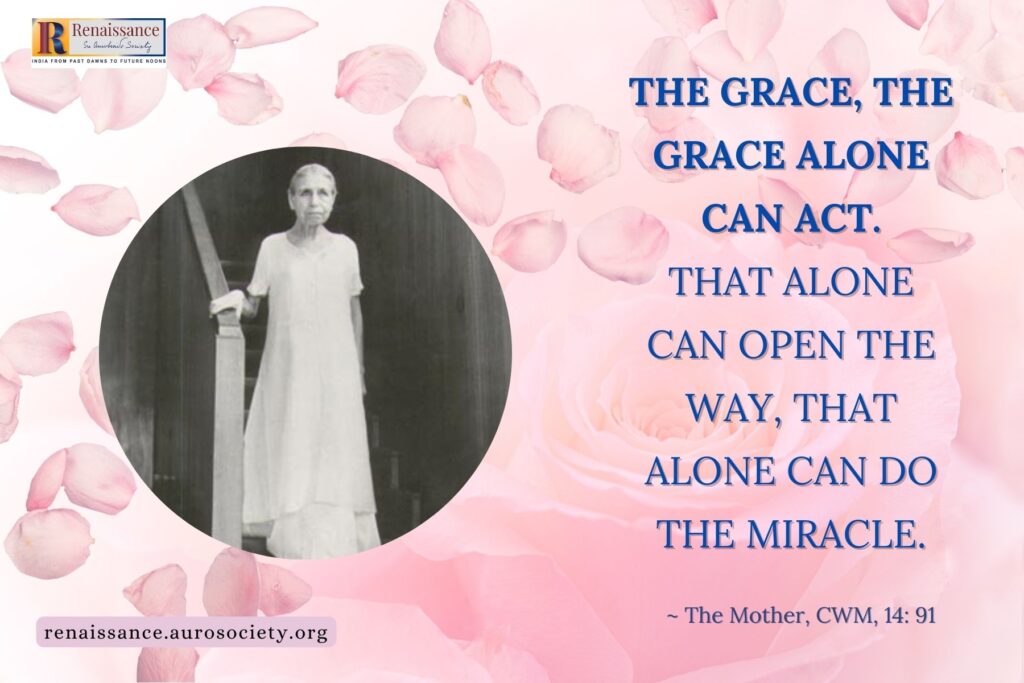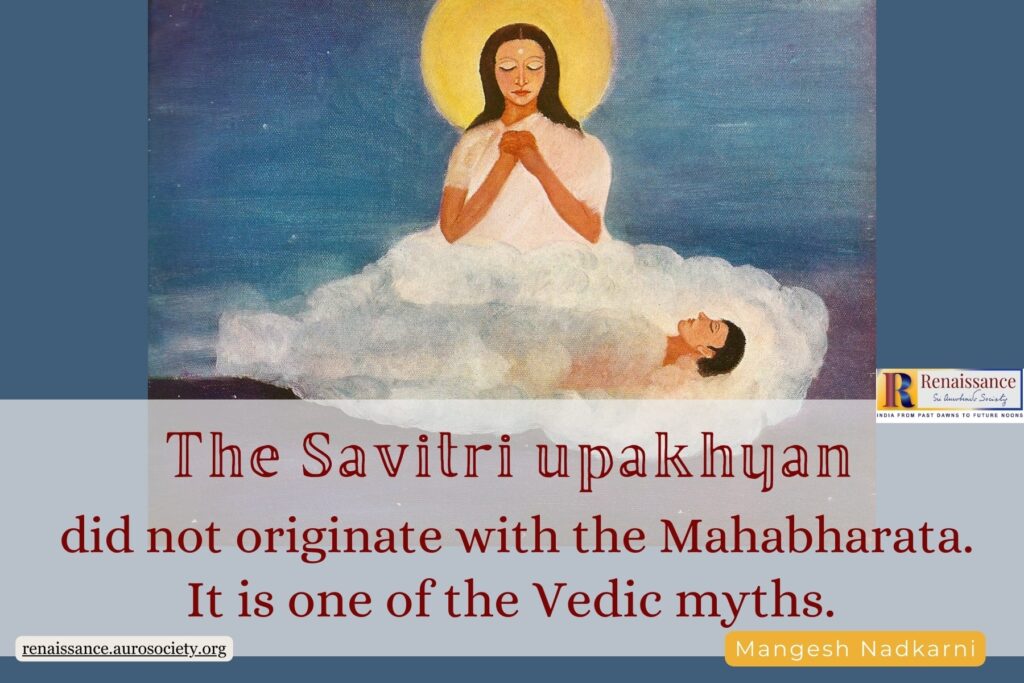Continued from PART 1
The Poetic Vision
I will attempt to highlight some key concepts in the poetics of Sri Aurobindo for which I have immense appreciation. The phrase: “inner seeing and sense” is of utmost significance as a psychological instrument of the illuminative power. Here the stress is not only on the inwardness: it is also on sight.
The poet is fundamentally occupied with the activity of the eye – inner and outer. When he turns to the phenomena of earth, what he busies himself with is their ‘vivid imagery’. An image is something visual. A profound experience of shapes and colours is the poet’s speciality and it is this that is denoted by ‘seeing and sense.’ The perceiving, feeling, understanding consciousness of the poet arrives at an active point, an effective focus, through the function of seeing.
“Vision,” says Sri Aurobindo in The Future Poetry, “is the characteristic power of the poet, as is discriminative thought the essential gift of the philosopher and analytic observation the natural genius of the scientist.” (CWSA, Vol. 26, p. 31)
Again, in Sri Aurobindo’s words: “the native power of poetry is in its sight” and “the poetic vision of life is not a critical or intellectual or philosophic view of it, but a soul-view, a seizing by the inner sense”, and the poetic climax is, in its substance and form, “the rhythmic revelation or intuition arising out of the soul’s sight. . .” (CWSA, Vol. 26, p. 36)
The ancient Indian word for poet is Kavi.
A kavi is one who sees and discloses. Of course, the disclosing, the making manifest, the showing out is an integral part of the poet’s function. And it is this part that is stressed in the Latin term poeta from the Greek poetes, which translates to “maker”, “fashioner”, “creator”. But the entire effort behind its formation lies in rendering visible, in ushering us to see, what has been seen by the one who forms.
The seeing happens first; it is then followed by its frame and communication.
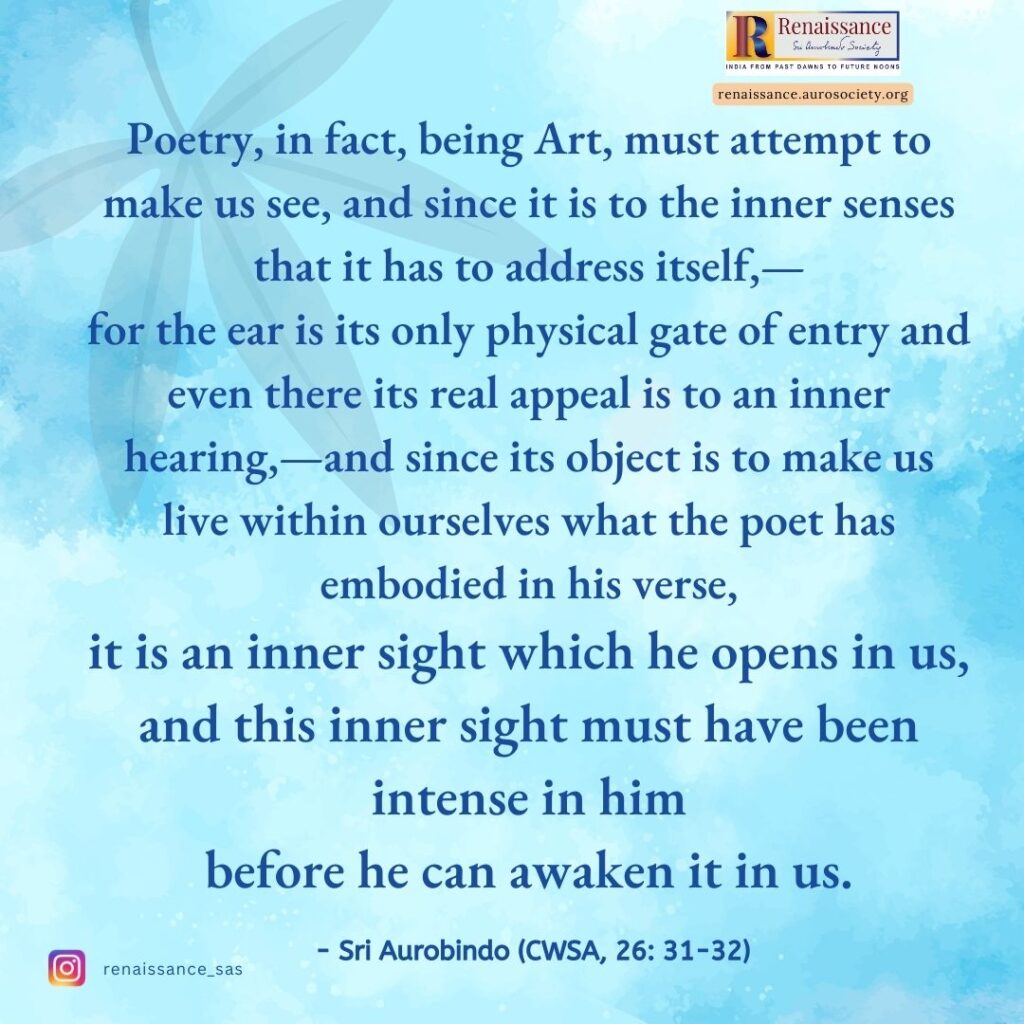
The Future Poetry and Overhead Aesthesis
The Future Poetry by Sri Aurobindo first appeared serially in the monthly Arya, between December 1917 and July 1920 in 32 instalments. It was however never published in a book form during his lifetime; in the 1940s, he wanted to update and expand it extensively in several ways, but never found the time for it.
The adjective “future” in Future Poetry needs the right perspective of the issues involved. But if The Future Poetry written more than a hundred years ago essentially speaks of the “inspired and inevitable” word, the mantric utterance of the Rig Veda, the Rig Veda in which it is already present—that “future” is as long ago as some ten thousand years.
If so, then how should we approach the adjective “future”?
Glimpses of it are found in the following ideations. In the 1930s, in his later construct of the aesthetic theory of poetry, in his Overhead Aesthesis, Sri Aurobindo describes four planes from where the poetic inspiration can spring from: Higher Mind, Illumined Mind, Intuition and Overmind, the last considered to be the origin of the inspired and inevitable Word carrying with it the most intense mantric utterance.
Still, could there be higher possibilities waiting to enter into this luminously evolved utterance? It is the evolving of our speech on that ladder of ascension. Not only thoughts and images, many sounds go to create a poem, flowing through its very being, enriching its soul with great joy.
So then the utterance in Overhead Poetry arises from some higher plane carrying with it its rhythm and tonal resonance, with undertones and overtones, rich with harmonics, as much as its substance and flavour. It is a creative word that sets into motion new powers of perception; also giving birth to the surge of new energies and their forces to shape our lives in their likeness.
In terms of a Savitri-phrase, it is “a voice that carries the sound of infinity.”
To enter into the spirit of Overhead Poetry and derive utmost joy from it, one has to find another level of aesthetic sensibility. An intuitive association with what is around and sounds puts us in direct contact with it. Only with a new taste, a fresh spirit in poetry can be infused.
Such then are the expectations from the poetry of the future.
Intense Yoga of the Overhead Aesthesis needs to be practised if there is to be that driving inspiration behind all our poetic engagements. Although The Future Poetry was given more than a hundred years ago, it is revealed on such an immense scale in later sonnets and Savitri with resounding victory.
Sri Aurobindo reiterates the essential power of the poetic word, that which makes us see, not just makes us think or feel. All great poetry comes about by a unison of these three elements. . . ” He continues:
. . . the poet has to make us live in the soul and in the inner mind and heart . . . and for that he must first make us see by the soul, in its light and with its deeper vision. . .
~ CWSA, Vol. 26, pp. 26-27
He is, as the ancients knew, a seer and not merely a maker of rhymes, not merely a jongleur, rhapsodist or troubadour, and not merely a thinker in lines and stanzas. He sees beyond the sight of the surface mind and finds the revealing word, not merely the adequate and effective, but the illumined and illuminating, the inspired and inevitable word, which compels us to see also.
To arrive at that word is the whole endeavour of poetic style.
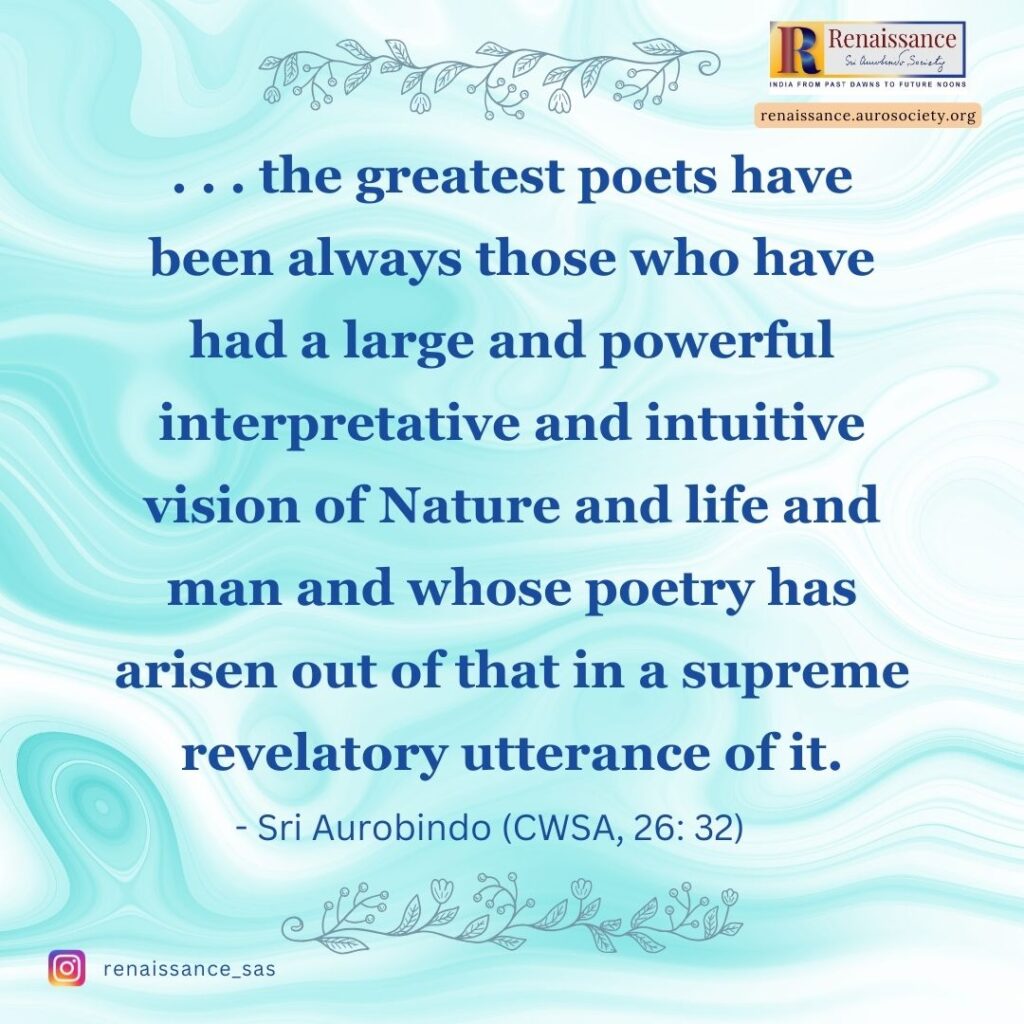
K. D. Sethna expands on the idea when he writes:
There is a certain power of revelation in which one looks beyond the image at more than what through the image is seized. One sees beauty even in the formless that stands beyond sight, hears sounds coming from silence.
~ Sri Aurobindo – the Poet
This is a sensitivity, a new aesthetic receptiveness; doors open to joys that come from beyond. The intuitive revelatory abundances flood us.
The sources of poetic inspiration can be from various places, spiritual, mystical, occult, inner worlds, lyrical, psychic, life-forces, strong physical actions, with some deeper power of vision and creation, character of rhythm and expression, with the right word at the right place,. . .
We find an example of this inner seeing in one of Sri Aurobindo’s early poems A Tree:
Holds up its topmost boughs
Like fingers towards the skies they cannot reach,
Earth-bound, heaven amorous.
This is the soul of man. Body and brain
Hungry for earth our heavenly flight detain.
– Sri Aurobindo, ‘A Tree’, CWSA, Vol. 2, p. 207
In the Indian theory of speech, we speak of the descent of the Transcendental Speech, Parā Vāṇī or Parā Vāk, into the language of the mental being, occurring through the stages of Pashyanti, Madhyamā to Vaikhari, the Seeing, the Middle into the human Speech, the Speech of the Mental Being.
What The Future Poetry is proposing is reaching upward towards Parā Vāk — to the higher and higher grades. It is an attempt to get the three intensities in our expression — highest intensity of rhythmic movement, highest intensity of thought-substance, and the highest intensity of soul-vision. That is what he meant when he said he was using Savitri as a means of ascension.
Also read:
“To read Savitri is indeed to practise Yoga”
Sri Aurobindo’s poem ‘Bliss of Identity’ is another great example of poetry being an expression of three highest intensities.
All Nature is taught in radiant ways to move,
All beings are in myself embraced.
O fiery boundless Heart of joy and love,
How art thou beating in a mortal’s breast!
It is Thy rapture flaming through my nerves
And all my cells and atoms thrill with Thee;
My body Thy vessel is and only serves
As a living wine-cup of Thy ecstasy.
I am a centre of Thy golden light
And I its vast and vague circumference;
Thou art my soul great, luminous and white
And Thine my mind and will and glowing sense.
Thy spirit’s infinite breath I feel in me;
My life is a throb of Thy eternity.
~ Sri Aurobindo, Bliss of Identity, CWSA, Vol. 2, p. 601
Besides being a mystic poet, Sri Aurobindo was also a great epic poet.
He was the first Indian English poet to write a successful epic in English. Savitri is based on a story from the Mahabharata. It is inspired in style by Milton’s ‘Paradise Lost’ in respect of blank verse, similes and seriousness. The blank verse used in the epic is grand like that of Milton.
In this epic, Sri Aurobindo makes a blend of his spiritual experiences, mystic vision and deep philosophical truths. This monumental work comprises of 12 books containing 49 cantos. He uses a variety of styles in it — dramatic, romantic, and narrative when occasion needs.
READ:
What Basically is Savitri? – A Brief Commentary
It was the hour before the Gods awake,
Across the path of the divine Event
The huge foreboding mind of Night, alone
In her unlit temple of eternity,
Lay stretched immobile upon Silence’ marge.
Almost one felt, opaque, impenetrable,
In the sombre symbol of her eyeless muse
The abysm of the unbodied Infinite,
A fathomless zero occupied the world.
A power of fallen boundless self awake
Between the first and the last Nothingness,
Recalling the tenebrous womb from which it came,
Turned from the insoluble mystery of birth
And the tardy process of mortality
And longed to reach its end in vacant Nought.
As in a dark beginning of all things,
A mute featureless semblance of the Unknown
Repeating for ever the unconscious act,
Prolonging for ever the unseeing will,
Cradled the cosmic drowse of ignorant Force
Whose moved creative slumber kindles the suns
And carries our lives in its somnambulist whirl.
~ Sri Aurobindo; Savitri, CWSA, Vol. 33, p. 1
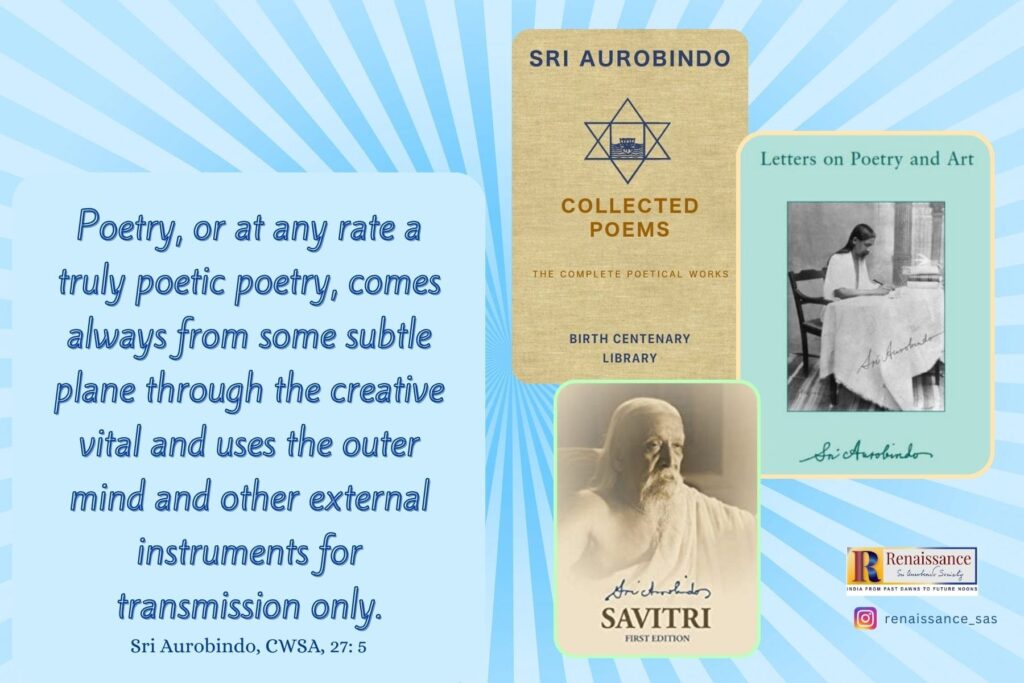
Sri Aurobindo’s Translations
What also strikes me as remarkable is Sri Aurobindo’s translations of selections of classical literature of India. Richard Hartz writes,
While Sri Aurobindo brought his gifts for epic and dramatic poetry to translating Sanskrit literature, when it comes to his translations from Bengali, what one is drawn to most is his mastery of the lyrical style. A notable contribution is the manner in which he made the beauty of Vaishnava bhakti poetry accessible to the reader of English. This included the poetry of Vidyapati (c 1352-1448).
~ Chapter in ‘Reading Sri Aurobindo’ edited by Gautam Chikarmane & Devdip Ganguli
Here is a sample of Bidyapati’s poetry which Sri Aurobindo translated:
I know not what this lovely thief
Did to me in that moment brief.
Surely such craft none yet possessed!
He robbed my heart out of its nest
Only with seeing, and gone is he
Taking my poor heart far from me.
And ah! his eyes did then express
Such tenderness, such tenderness,
The more I labour to forget
My very soul remembers it.
Mourn not, sweet girl, for thy heart’s sake;
Who took thy heart, thyself at last shall take.
It is well known that in 1915, with help from poet and friend Subramania Bharati, Sri Aurobindo published translations of a few poems of Tamil Vaishnava saints of the eighth and ninth centuries in Arya. Sometime later, he rendered into English the classic text on ethics and morality, the Kural, written by the ancient poet and philosopher Thiruvalluvar.
SEE in this issue:
Sri Aurobindo’s Translations from Tamil
Some Concluding Thoughts
As someone devoted to the Aurobindonian sensibility and as a contemporary poet writing in English in India today, I firmly believe Sri Aurobindo’s poetry should become accessible to all serious students of Literature. I am in total consensus with R.Y Deshpande when he writes (he has shared similar thoughts in some of the conversations I’ve had with him):
Should Sri Aurobindo be taken to the academic world? Yes he should be, if English poetry is a subject of academic studies in these great institutions. But not just because of his 3000 pages of poetic writings, certainly not for that reason. Apply any test of sound literary criticism, old or new, and one will find every satisfaction in them, the gladness of a deep or speeding creation.
~ The World of Sri Aurobindo’s Poetry, November 2020
Yet there is something far more than that; there is the new art of expression, there is the new spirit of love and joy and beauty and lyricism, there is the winging of many-coloured birds, and countless birds of countless variety, in many a colourful sky of marvel and surprise, of sense and sound and sight.
There is the new stream of inspiration that flows and floods these pages and pages, its mellifluence in every little phrase and idiom; there are the perfect revelations of aesthetic enjoyment and promises in them.
I am convinced of the undoubtedly ‘great illuminative power’ of Sri Aurobindo’s poetry which shows us unequivocally the ways of Integral Yoga, bringing about definitive transformations in our life at so many levels.
CONCLUDED

Go to PART 1
About the author:
Gayatri Majumdar is founder, editor, publisher of critically acclaimed literary journal, The Brown Critique. Her books include: Shout, I Know You Are Here and The Dream Pod (poetry collections), A Song for Bela (a novel), The lotus of the heart (non-fiction) and ‘Home’ anthology, which she co-edited. Widely published in numerous Indian and international journals and anthologies, she is finalizing her fourth book of poems tentatively titled A Warm Place With no Memory.
As co-founder of ‘Pondicherry Poets’, Gayatri has been curating the prestigious annual Pondicherry/ Auroville Poetry Festival. She often features poets/artists/musicians on the BrownCritique YouTube channel. She lives in Pondicherry and is associated with Sri Aurobindo Society.

~ Design: Beloo Mehra

